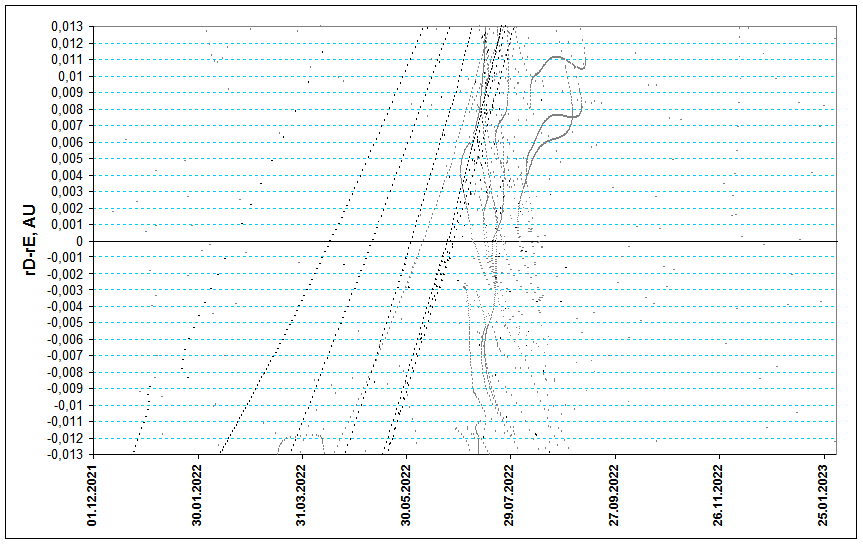Tau-Herculids: prediction of activity
to the list of predictions

Fig. 1. Space-temporal projection of tau-Herculid trails parts onto their minimal distance passages in 2022 for the post-perihelion part of the particles orbits (correspondence between colours of the particles and their ejection velocities can be seen here).

Fig. 2. Space-temporal projection of tau-Herculid trails parts onto their minimal distance passages in 2022 for the pre-perihelion part of the particles orbits (correspondence between colours of the particles and their ejection velocities can be seen here).
31.05.2022 3:11 UT. Encounter with 1892-1941 trails. During the given period of time meteor activity with ZHRmax up to 50 is expected, low brightness. Also some activity up to 20 meteors on ZHR scale are likely, especially around 15:10 UT. Theoretical radiant: RA=206.7°, Dec=+26.0°, v=11.7 km/s.
31.05.2022 5:15 UT. Ecounter with 1979-1995 trails. For the given period of time the basic model gives meteor activity with ZHRmax of 600-700 is expected. However, considering that in 1995 the comet 73P broke into several parts, the real activity should be one-two orders higher, up to 10000-100000 meteors on ZHR scale with high average brigntness. Theoretical radiant: RA=209.5°, Dec=+28.0°, v=12.1 km/s.
26.06.2022 2:58 UT. Encounter with 1930 trail. During the given period of time meteor activity with ZHRmax of 2-3 is expected, very low brightness. Theoretical radiant: RA=170.0°, Dec=-10.2°, v=9.3 km/s.
The expected timing of 31 May outbursts makes them favorable for observing in the western hemisphere. The Moon near new phase will not create any problems for observation.
Ссылки
1. Программа С. Шанова и С. Дубровского "Comet's dust 2.0". [Использована для расчета орбитальной эволюции метеорных частиц]
2. Lyytinen E, van Flandern T. "Predicting the strength of Leonid outbursts", 2000, Icarus, P. 158-160.
3. Казуо Киносита, http://www9.ocn.ne.jp/~comet/index.html [Орбитальные элементы кометы 73P/Schwassmann-Wachmann 3.]
4. Jenniskens P. Meteor showers and their parent comets, 2006, 780 p.
31.05.2022 5:15 UT. Ecounter with 1979-1995 trails. For the given period of time the basic model gives meteor activity with ZHRmax of 600-700 is expected. However, considering that in 1995 the comet 73P broke into several parts, the real activity should be one-two orders higher, up to 10000-100000 meteors on ZHR scale with high average brigntness. Theoretical radiant: RA=209.5°, Dec=+28.0°, v=12.1 km/s.
26.06.2022 2:58 UT. Encounter with 1930 trail. During the given period of time meteor activity with ZHRmax of 2-3 is expected, very low brightness. Theoretical radiant: RA=170.0°, Dec=-10.2°, v=9.3 km/s.
The expected timing of 31 May outbursts makes them favorable for observing in the western hemisphere. The Moon near new phase will not create any problems for observation.
Ссылки
1. Программа С. Шанова и С. Дубровского "Comet's dust 2.0". [Использована для расчета орбитальной эволюции метеорных частиц]
2. Lyytinen E, van Flandern T. "Predicting the strength of Leonid outbursts", 2000, Icarus, P. 158-160.
3. Казуо Киносита, http://www9.ocn.ne.jp/~comet/index.html [Орбитальные элементы кометы 73P/Schwassmann-Wachmann 3.]
4. Jenniskens P. Meteor showers and their parent comets, 2006, 780 p.